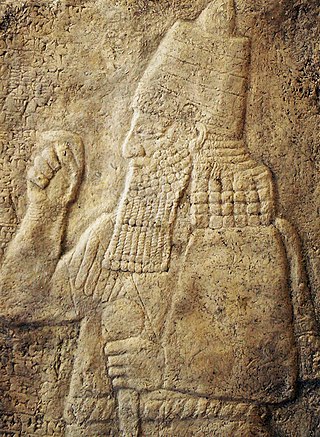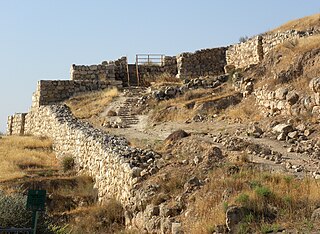The Book of Nahum is the seventh book of the 12 minor prophets of the Hebrew Bible. It is attributed to the prophet Nahum, and was probably written in Jerusalem in the 7th century BC.

Hezekiah, or Ezekias, was the son of Ahaz and the 13th king of Judah according to the Hebrew Bible.

The Kingdom of Judah was an Israelite kingdom of the Southern Levant during the Iron Age. Centered in the highlands of Judea, the landlocked kingdom's capital was Jerusalem. Jews are named after Judah, and primarily descend from people who lived in the region.

Nineveh, also known in early modern times as Kouyunjik, was an ancient Assyrian city of Upper Mesopotamia, located in the modern-day city of Mosul in northern Iraq. It is located on the eastern bank of the Tigris River and was the capital and largest city of the Neo-Assyrian Empire, as well as the largest city in the world for several decades. Today, it is a common name for the half of Mosul that lies on the eastern bank of the Tigris, and the country's Nineveh Governorate takes its name from it.

Sennacherib was the king of the Neo-Assyrian Empire from the death of his father Sargon II in 705 BC to his own death in 681 BC. The second king of the Sargonid dynasty, Sennacherib is one of the most famous Assyrian kings for the role he plays in the Hebrew Bible, which describes his campaign in the Levant. Other events of his reign include his destruction of the city of Babylon in 689 BC and his renovation and expansion of the last great Assyrian capital, Nineveh.

Lachish was an ancient Canaanite and Israelite city in the Shephelah region of Israel, on the south bank of the Lakhish River, mentioned several times in the Hebrew Bible. The current tell (ruin) by that name, known as Tel Lachish or Tell ed-Duweir, has been identified with the biblical Lachish. Today, it is an Israeli national park operated and maintained by the Israel Nature and Parks Authority. It lies near the present-day moshav of Lakhish.

The Assyriansiege of Jerusalem was an aborted siege of Jerusalem, then capital of the Kingdom of Judah, carried out by Sennacherib, king of the Neo-Assyrian Empire. The siege concluded Sennacharib's campaign in the Levant, in which he attacked the fortified cities and devastated the countryside of Judah in a campaign of subjugation. Sennacherib besieged Jerusalem, but did not capture it.

Matthew 1:10 is the tenth verse of the first chapter in the Gospel of Matthew in the Bible. The verse is part of the section where the genealogy of Joseph, the father of Jesus, is listed.

Matthew 1:9 is the ninth verse of the first chapter of the Gospel of Matthew in the Bible. The verse is part of the non-synoptic section where the genealogy of Joseph, the legal father of Jesus, is listed, or on non-Pauline interpretations the genealogy of Jesus. The purpose of the genealogy is to show descent from the line of kings, in particular David, as the Messiah was predicted to be the son of David, and descendant of Abraham.

David Ussishkin is an Israeli archaeologist and professor emeritus of archaeology.

The Neo-Assyrian Empire arose in the 10th century BC. Ashurnasirpal II is credited for utilizing sound strategy in his wars of conquest. While aiming to secure defensible frontiers, he would launch raids further inland against his opponents as a means of securing economic benefit, as he did when campaigning in the Levant. The result meant that the economic prosperity of the region would fuel the Assyrian war machine.

Lakhish is a moshav in the northern Negev in south-central Israel. Located south-east of Kiryat Gat, it falls under the jurisdiction of Lakhish Regional Council. In 2022 it had a population of 819.
Sennacherib's Annals are the annals of the Assyrian king Sennacherib. They are found inscribed on a number of artifacts, and the final versions were found in three clay prisms inscribed with the same text: the Taylor Prism is in the British Museum, the Oriental Institute Prism in the Oriental Institute of Chicago, and the Jerusalem Prism is in the Israel Museum in Jerusalem.

The Lachish reliefs are a set of Assyrian palace reliefs narrating the story of the Assyrian victory over the kingdom of Judah during the siege of Lachish in 701 BCE. Carved between 700 and 681 BCE, as a decoration of the South-West Palace of Sennacherib in Nineveh, the relief is today in the British Museum in London, and was included as item 21 in the BBC Radio 4 series A History of the World in 100 Objects by the museum's former director Neil MacGregor. The palace room, where the relief was discovered in 1845–1847, was fully covered with the "Lachish relief" and was 12 metres (39 ft) wide and 5.10 metres (16.7 ft) long. The Lion Hunt of Ashurbanipal sequence was found in the same palace.

The siege of Azekah was a battle between the Neo-Assyrian Empire and the Kingdom of Judah. It preceded the Siege of Lachish, making it the first known clash between the two kingdoms during Sennacherib's campaign in Judah. The most important source for the battle is the Azekah Inscription. The battle is not mentioned in the Hebrew Bible.

2 Kings 18 is the eighteenth chapter of the second part of the Books of Kings in the Hebrew Bible or the Second Book of Kings in the Old Testament of the Christian Bible. The book is a compilation of various annals recording the acts of the kings of Israel and Judah by a Deuteronomic compiler in the seventh century BCE, with a supplement added in the sixth century BCE. This chapter records the events during the reign of Hezekiah, the king of Judah, a part of the section comprising 2 Kings 18:1 to 20:21, with a parallel version in Isaiah 36–39.

2 Kings 19 is the nineteenth chapter of the second part of the Books of Kings in the Hebrew Bible or the Second Book of Kings in the Old Testament of the Christian Bible. The book is a compilation of various annals recording the acts of the kings of Israel and Judah by a Deuteronomic compiler in the seventh century BC, with a supplement added in the sixth century BC. This chapter records the invasion of Assyrian to Judah during the reign of Hezekiah, the king of Judah, a part of the section comprising 2 Kings 18:1 to 20:21, with a parallel version in Isaiah 36–39.

2 Chronicles 32 is the thirty-second chapter of the Second Book of Chronicles in the Old Testament in the Christian Bible or of the second part of the Books of Chronicles in the Hebrew Bible. The book is compiled from older sources by an unknown person or group, designated by modern scholars as "the Chronicler", and had its final shape in late fifth or fourth century BCE. This chapter belongs to the section focusing on the kingdom of Judah until its destruction by the Babylonians under Nebuchadnezzar II and the beginning of restoration under Cyrus the Great of Persia. The focus of this chapter is the reign of Hezekiah, king of Judah.

Sennacherib's campaign in the Levant in 701 BCE was a military campaign undertaken by the Neo-Assyrian Empire to bring the region back under control following a rebellion against Assyrian rule in 705 BCE. After the death of Sargon II, Sennacherib’s father, a number of states in the Levant renounced their allegiance to Assyria. The rebellion involved several small states: Sidon and Ashkelon and Byblos, Ashdod, Ammon, Moab, and Edom who then submitted to the payment of tribute to Assyria. Most notably, Hezekiah of Judah, encouraged by Egypt, joined the rebellion and was subsequently invaded by the Assyrians who captured most of the cities and towns in the region. Hezekiah was trapped in Jerusalem by an Assyrian army and the surrounding lands were given to Assyrian vassals in Ekron, Gaza, and Ashdod, however, the city was not taken and Hezekiah was allowed to remain on his throne as an Assyrian vassal after paying a large tribute. The events of the campaign in Judah are famously related in the Bible which culminate in an “angel of the Lord” striking down 185,000 Assyrians outside the gates of Jerusalem prompting Sennacherib’s return to Nineveh.

The Assyrian conquest of Egypt covered a relatively short period of the Neo-Assyrian Empire from 673 to 663 BCE. The conquest of Egypt not only placed a land of great cultural prestige under Assyrian rule but also brought the Neo-Assyrian Empire to its greatest extent.

























